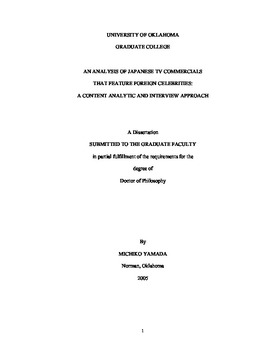| dc.contributor.advisor | Kramer, Eric M., | en_US |
| dc.contributor.author | Yamada, Michiko. | en_US |
| dc.date.accessioned | 2013-08-16T12:19:36Z | |
| dc.date.available | 2013-08-16T12:19:36Z | |
| dc.date.issued | 2005 | en_US |
| dc.identifier.uri | https://hdl.handle.net/11244/816 | |
| dc.description.abstract | Overall, though Japan and the US are almost the same economically, the information flow is almost always one-way, from the US to Japan. In Japan, Western celebrities, Hollywood movies, and other American television programs, music, and magazines have all penetrated into Japanese society. On the other hand, the American audience does not know much about Japanese culture, except for some cartoons and animated characters. There are almost no Japanese celebrities seen in American television commercials, and few Japanese movies are available in theaters. Therefore, the US is a rather closed country in terms of media, though it is an open country in terms of interpersonal acceptance. On the other hand, Japan is a closed country in terms of interpersonal acceptance, but a rather open country in terms of media. | en_US |
| dc.description.abstract | The results showed a very high rate of European language penetration into Japanese commercials. Almost half of the commercials had either Japanese or Western celebrities, which showed the dependence of Japanese commercials on having celebrities. In terms of background, foreigners appeared to be structurally associated with urban, rather than rural, environments. Third, interviews were conducted with professionals including ad agents and professors. The total number of interviewees was 43. According to these interviews, the main reason for Japanese television commercials to have Western celebrities seems to be the Western celebrities' popularity. Interviews also indicate a Japanese inferiority complex toward the West and especially Caucasians. | en_US |
| dc.description.abstract | I utilized three methodologies: semiology, content analysis, and interview. First, I analyzed 11 Japanese commercials by semiology. This semiological analysis reveals the significance of having Western celebrities in Japanese TV commercials. Second, I collected 6,424 Japanese commercials, randomly selected 25% of them, or 1,606 commercials, and examined the tendency of utilizing foreigners and Western celebrities in them. | en_US |
| dc.description.abstract | In this dissertation, by examining the meaning of Western celebrities in Japanese television commercials, I have proven the existence of a one-way flow of information between the US and Japan. In Japan, many television commercials have celebrities, not only Japanese but also Western celebrities. | en_US |
| dc.format.extent | ix, 284 leaves ; | en_US |
| dc.subject | Television advertising Japan. | en_US |
| dc.subject | Celebrities in mass media Japan. | en_US |
| dc.subject | Mass Communications. | en_US |
| dc.title | An analysis of Japanese TV commercials that feature foreign celebrities: A content analytic and interview approach. | en_US |
| dc.type | Thesis | en_US |
| dc.thesis.degree | Ph.D. | en_US |
| dc.thesis.degreeDiscipline | Department of Communication | en_US |
| dc.note | Source: Dissertation Abstracts International, Volume: 65-11, Section: A, page: 4037. | en_US |
| dc.note | Adviser: Eric M. Kramer. | en_US |
| ou.identifier | (UMI)AAI3152839 | en_US |
| ou.group | College of Arts and Sciences::Department of Communication | |
